In an attempt to better understand the sharp, rusty sliver of the American underground that worked its way into my cold and slowly-beating heart about a quarter century ago, I’ve given myself the task of tracking down and interviewing all of my heros in the world of zines. Today’s interview is with John Marr, the man behind Murder Can Be Fun, who I tracked down in San Francisco.
[above: A young John Marr can be seen in the audience of a punk show at San Francisco’s Mabuhay Gardens in the early 1980s. Photo courtesy of The SF Chronicle/Examiner’s “pink section.”]
MARK: As I know very little about you, let’s start at the very beginning… Do you know the circumstances of your birth?
JOHN: Nothing too startling there. Like most kids of my vintage/class, I was born in a hospital.
MARK: Where abouts?
JOHN: Oakland, California, I’m proud to say, unlike most kids of my vintage/class.
MARK: And what do you think of Oakland today compared to the Oakland of your youth.
JOHN: I’ve always loved Oakland. I am sufficiently old to remember Oakland when not only were there stores–big stores!–downtown, but the merchants decorated the (crowded) streets for Christmas! Unfortunately, the one-two punch of white flight and the construction of BART sent the downtown area into a tailspin in the ‘70s from which it didn’t emerge until well into this century. Not that it stopped me–through the ‘80s and ‘90s I loved to go thrifting and used book shopping downtown, and I loved gawking at all the old, almost empty and unloved buildings and all the weird stuff down there, the taxi dance hall, the sleazy movie theater (now a Goodwill), the trashy bars…. One grimy used bookstore run by an insane woman had fewer books than I did. I even worked for a time in college at an absolutely wonderful used bookstore downtown, the Holmes Book Company. It may not have been the best used bookstore, but it definitely had the best used book store atmosphere.
MARK: I’ve heard it said that the Holmes Book Company building is haunted. Did you ever have any ghostly encounters while there?
JOHN: No, I think the ghost story is a lot of nonsense. Yes, I did see a few flying books–but all originated in the the hands of me or one of my fellow shelvers. The only weird thing I remember is the manager’s bicycle somehow disappearing from the basement. Perhaps the ghost rode away?
MARK: Back to the Oakland of today… I believe we were talking about how the city today is different than it was in your youth….
JOHN: Downtown, and much of Oakland, for that matter, is getting gentrified now. The city is overrun with hipsters. And I’m fine with that. Oakland deserves the love, and I’d rather see people sitting on the sidewalks at night eating overpriced cheese than the empty streets of the old days. But I miss the old stuff, too, especially the Doggie Diner. And I love doing things like telling the manager of the cool punk rock/heavy metal club that I used to eat dinner with my family there in 1965, or inform the owner of the hip radical bookstore that his space used to be occupied by Billy Graham Bible Books.
[above: Marr with the Doggie Diner dog heads in 2000.]
MARK: I know it’s kind of off topic, as we’re supposed to be talking about death, disaster and zines, but, having never eaten at the Doggie Diner, I’m curious is you could tell me what made the place so special. I’ve heard about the chain for years, and I’ve seen the iconic, giant doggie heads, but I’m curious as to what you liked about the place.
JOHN: To be honest, the dog heads were the only thing special about the place–but they were really, really special! I don’t recall anything special about the food, certainly nothing that you couldn’t get at other equally classic, if dog-less, local hamburger stands, like Kwik Way, or Space Burgers. I hadn’t eaten at a Doggie Diner for many years until I went to one of the last ones (in Alameda) in the mid-80s. At that point, I can vouch for the fact that the food was terrible, salty enough to kill snails.
[above: Marr with the doggies again, 17 years later, in 2017.]
MARK: So, what did your parents do, back in the day, when you were all eating together at what’s now the cool Oakland punk club?
JOHN: My father was a cop, and my mother was primarily what we called a “homemaker” in those days, although she did have various part-time jobs over the years.
MARK: So your dad would have been a cop in the Bay Area around the time of the Zodiac Killer?
JOHN: Yes. He was even mentioned in Graysmith’s book, albeit not by name, due to his tangential connection to a dead end… The Zodiac stayed out of Oakland, though.
MARK: What, if you don’t mind my asking, was the tangential connection?
JOHN: He did some questioned document examination that, like all trails in the case, went nowhere.
MARK: What kinds of documents are we talking about?
JOHN: That, I can’t say.
MARK: Do you think your interest in homicide perhaps has its roots in your dad’s profession? Did your family talk murder around the kitchen table?
JOHN: No, not at all. For most of my childhood, my father was on the motorcycles, duty he dearly loved. He later went plainclothes, working burglary and forgery, among other things. He never worked homicide, though. He was pretty good about leaving the job at work, save for the occasional tale of a grisly accident. OK, and we did play a car game called “Spot the Hooker,” which I understand was unique to my family. If I picked up anything, it was a black sense of humor. But I suspect it was innate.
MARK: How does one play “Spot the Hooker”? Is there some kind of point system… I might want to play with my kids sometime.
JOHN: Sorry, it was more of a casual observational activity than a structured game. But I did learn to tell the difference between people working the corner, and people waiting at the corner.
MARK: Have you ever lived outside of California?
JOHN: No, I’ve lived my entire life in the central Bay Area; San Francisco, Oakland, Berkeley, and Contra Costa County.
MARK: What’s your first memory?
JOHN: In a crib, I kid you not.
MARK: Mine too. I have this distinct memory of laying in my crib, watching a yellow curtain flutter in the breeze on a warm summer day… What do you remember about your crib?
JOHN: I have multiple memories of lying there, looking up at my parents, being unable to adjust the pillow to my satisfaction, being slightly annoyed at being caged…
MARK: What were you like as a kid, once you emerged from your crib/cage?
JOHN: I was very bookish. I remember being very upset on Sunday mornings, walking into the living room room, where my parents and older sister were all reading the Oakland Tribune, and not being able to join them, as I was only four or so. I can recall my mother at times literally ordering me to go outside to play, and it wasn’t because I was watching TV. (I was never a big fan of television.) My parents didn’t really push me, so I wasn’t an early reader. Once I hit school, and got promoted into the fast reader group, I made up for lost time.
MARK: What were your folks like?
JOHN: Very normal, very middle class, except for a little more black humor and a lot more books. I was routinely shocked at how few books were in the homes of my friends.
MARK: Is it just your interest in murder that makes you different, or is there more to it?
JOHN: My tastes and tendencies have always been a bit offbeat. I think I had accumulated a library of 500 or 600 books by the time I was 10 years old, which was about 495 more books than were in the homes of most of my schoolmates. And, even the ones that were standard kid stuff, weren’t. Like some of my peers, I really got into the Hardy Boys. But unlike everyone else, I didn’t like the series that was rewritten in the 1950s. I preferred the original volumes, which I picked up at library sales, where Frank and Joe cruised around in roadsters and coupes, and sometimes carried guns, and people got killed! My father was always bewildered by the fact that, as a teenager, I preferred rummaging through used bookstores to working on cars.
MARK: Did you share Murder can Be Fun with your folks? If so, what did they make of it?
JOHN: Yes. They both like it, although my mother would prefer I wrote about more light-hearted subjects.
MARK: What was your first job?
JOHN: Outside of a stint delivering newspapers, and the usual assortment of odd jobs available to kids in my suburb, like doing yard work and collecting recycling, my first job was as an office flunky in a retirement account management company when I was 16… Was it a coincidence that one of my co-workers wound up on the wrong end of a murder suicide that summer? Perhaps.
MARK: Were you close with the person in question?
JOHN: Not especially, I can’t even remember her name. But I do remember her boyfriend’s car. It was a Camaro-like muscle car, and it had a license plate that said something like “8INCHES.” He was a total creep, as only existed in the 1970s.
MARK: So he killed her, and then himself? Or was it the other way around?
JOHN: He did all the work, in the classic manner.
MARK: Were there other murders in your youth?
JOHN: Well, I did grow up with two murderers! One was the kid of family friends. I played with her as a small child. She grew up to shoot up a shopping mall. The other one was in my kindergarten class, we were friends. He came to my birthday party!. Years later, when we were in high school, he smashed an old lady’s head in with a brick. We had long since drifted into different social circles, though. And it came out many years later there was a serial killer preying on the children of my suburb. He only killed a kid every few years, though, so the serial killer thing wasn’t really noticed at the time. The term “serial killer” hadn’t even been invented yet… One of my friends was even briefly suspected of having committed one of the murders.
MARK: What was the name of that serial killer, and did you ever write about him in Murder Can Be Fun?
JOHN: At first, most of the killings were attributed to Phillip Hughes. But subsequent cold case DNA work pinned some of his victims on Charles “Junior” Jackson and Daryl King. I never wrote about any of these cases for Murder Can Be Fun, though.
MARK: It’s probably worth noting at this point that Murder Can Be Fun was about more than just murder, right? I mean, you also touched on your share of disasters…
JOHN: Oh, yes. As a matter of fact, I think I preferred to write about accidents and disasters. So many of my favorite stories — the Disney deaths, the zoo deaths, the Boston Molasses Flood, the football/glass factory collapse — weren’t murder stories. At least not in the traditional sense!
MARK: How did you go about picking which cases you’d write about? Did you have specific criteria?
JOHN: The overwhelming criteria, of course, was that it had to pique my interest. Some ironic or darkly humorous element would help, but often sheer strangeness would suffice. And then it had to be somewhat obscure. I wanted to write about stuff most people had never heard of, for marketing reasons, as well as to satisfy my own curiosity. I’ve often thought one of my motivations was to rationalize some of these enormous and time-consuming research jobs.
[above: Photo of a hard-at-work John Marr by Bobby Waldman from Re/Search Zines vol. 2. Photo of the photo by Jeremy Bridges.]
MARK: Do you recall when you first became aware of the concept of murder?
JOHN: I remember being particularly impressed with Bluebeard at a very young age. The Brothers Grimm and their rivals were staples of my elementary school literary life. Some of the things Hans Christian Anderson had his characters do with nettles were creepy! When I was older, there were those great kiddy anthologies “edited” by Alfred Hitchcock for young readers. Straight up my alley!
MARK: What was it about Bluebeard specifically that made an impression on you?
JOHN: Although the stacks of decapitated bodies neatly stored in the closet was memorable, I don’t think it was any special element about the Bluebeard story beyond the fact it was the first one really horrific murder tale I was exposed to. The thumb-sucker in Heinrich Hoffman’s “Slovenly Peter” was also great preschool favorite, but I guess it doesn’t count since it’s only about mutilation, not murder.
MARK: Do you recall when you first became aware of zine culture, and the fact that people were out there in the world self-publishing?
JOHN: I first heard of zines in the early 1970s. One of the Tarzan paperbacks that I so eagerly devoured in those days included a few mostly out-dated addresses for Edgar Rice Burroughs zines. I eventually wound up subscribing to a series of these and other book-related zines, which in those dark pre-internet days was the only way to get any information about something that wasn’t absolutely mainstream. The ads were frequently more important than content–there was no other way to get this stuff! I eventually became a regular reader/subscriber of early paperback collecting zines.
I remember the first real “zine” zine I ever got, as opposed to a traditional fanzine devoted to fannish fawning over some aspect of media. It was in 1976 or so. I think it was called something like “The Bridge.” It was about the Brooklyn Bridge, very handsomely typeset and offset printed. Readers were encouraged to take photos of their foot the first time they stepped on the bridge. I think it was published by a Dutch guy — perhaps Piet Schreuders — who sent out a bunch of free copies to a list I happened to be on. I remember I couldn’t figure out what in the hell it was. Wished I’d saved it.
MARK: Could that zine you remember have possibly been the The Brooklyn Bridge Bulletin?
JOHN: It could have been. Was it based in Holland in 1976?
MARK: I’m not certain, but, in reading about it, I’m finding a lot of references to the Dutch, so I suspect there’s a connection… So, how did Murder Can Be Fun come about? Do you recall when you first had the idea?
JOHN: It’s a long and convoluted story. Like all persons of taste in the late ‘70s, I got involved in punk rock. After a few years of avid gig attendance, I became one of the early “shitworkers” on Maximum Rock n Roll. I strictly did grunt work that never went any further than editing some of the more mediocre scene reports. But I did learn some basic layout skills, and, more importantly, I got exposed to the world of punk rock zines… I remember Tim at one point throwing out two 6-foot tall stacks of zines people had sent him. This was about 1982! I discovered most of them sucked — not even Cometbus was very good back then! And I discovered that there were a lot of zines that would review other zines, most notably Factsheet Five. I thought I could do better, and had found an outlet. When I was in college, I working at that wonderful used bookstore in Oakland, and I remember the manager telling me, “Anyone can publish a book. The hard part is distributing a book.” These review zines, I thought, were the doorway to distribution!
As much as I loved punk rock, my primary interest remained weird books, especially those about strange murders and weird disasters. However, I did feel there were common themes between my literary and musical interests. Certainly people would be mildly interested when I would babble about this stuff at shows, and the RE/SEARCH books were touching on the same things. And then there was John Waters… After bending all my friend’s ears about the sicko Sylvia Likens murder, I was directed to check out the John Water’s book Shock Value. I knew, at that point, I was no longer alone.
I always wanted to write about this stuff. I couldn’t find any other zine that would publish it, so I figured I would have to do it myself. And I did.
MARK: I was just talking with author Phoebe Gloeckner not too long ago about her experience as a young punk of about 16 working for V Vale at Search and Destroy, and how influential that experience was for her, and it’s interesting to think that maybe, at roughly the same time, you were having a similar experience at Maximum Rock n Roll.
JOHN: Lucky Phoebe! I found a copy of the last S&D when I was 17 and absolutely worshipped it. One of the highlights of my life was when Vale called me up after reading an early issue of Murder Can Be Fun! I met Phoebe at a signing a few years ago, and we sort of bonded over our mutual affection for the works of Ira Lunan Ferguson. Ask her about Ferguson sometime, she has a great story about him!
MARK: OK, I’m making a note of it… Back to your life as a punk, I’m curious as to what specifically that attracted you to the scene?
JOHN: I mean, what was there not to like about punk in 1978? It was loud, fast, and new. It also incorporated a caustic, cynical world outlook with a heavy dose of black humor (the best kind!) and it was very much the antithesis of the oppressive 1970s suburban landscape that I was trapped in. I remember thinking, “The kind of people who would listen to this music would love to read Jim Thompson.” At least the ones who could read!
MARK: Did you ever try your hand at writing songs, performing, etc?
JOHN: Of course, I thought about it. What teenage music fan doesn’t think about being in a band? I made noises about learning bass. I even fiddled around on a friend’s bass a little bit. And I literally mean a little bit–I played Flipper’s “Sex Bomb” a few times. I quickly realized, though, that I had no ear, no sense of rhythm, and no other discernible musical ability, only a vague urge to participate and attract attention. Unlike so many others, I decided this meant I shouldn’t play music. I don’t regret it — we’ve all seen the sad results of those in similar situations who decided otherwise. This has not prevented me, though, from being the most important part of the music scene: the paying customer.
MARK: I seem to recall that Thrift Score publisher Al Hoff once told me that you and she met in college, well before the zines started. Is that correct?
JOHN: Yes. I was 20, she was 17, and we lived in the same dorm at UC Berkeley. We went thrift shopping together. Man, was she a monster thrifter! I also met Aaron Cometbus when I was living in Berkeley, although he of course was already publishing Cometbus (or, more accurately, the zine that would eventually be re-christened as Cometbus). I still remember being awed by his ability at PacMan pinball. We used to hang around this amazing second-floor pinball hall near campus that featured occasional punk rock shows and a guy at the change counter who would also sell you acid.
MARK: So how old were you when the first issue of Murder Can Be Fun came out? And how did you manage to get it printed?
JOHN: I was 24 or 25. It was no problem getting it printed, just go to the cheapest self-service copy place I could find and crank out 100 copies. I think it cost me $20 or something. The cover was so wretchedly laid out Factsheet Five thought the title was “Sex Drugs and Death” and reviewed it under that title.
MARK: And what kind of review did you get for that first issue? Do you remember?
JOHN: Fairly neutral, as I recall. Hey, it was my first issue–it sucked! I don’t think Gunderloy personally liked MCBF, as it wasn’t his kind of thing, but he was fair-minded enough to recognize that people who did like that sort of thing would like MCBF. I did get into the “top zines” feature once or twice during his tenure after I got better.
MARK: And where did the name Murder Can Be Fun come from?
JOHN: I had an absolutely brilliant title that I forgot! So I borrowed MCBF from a Fredric Brown novel, one of his lesser efforts (the novel, at least). But I think it encapsulated my sensibility, and it was short and memorable. And a good title will get you far in life!
MARK: Was there ever a point when murder stopped being fun for you?
JOHN: Although murder and disasters remain an interest, I think things sort of peaked with Jeffrey Dahmer. I mean, how could you top that?
MARK: So, no more true crime for you?
JOHN: No, it’s dropped off my person genre hit-parade. And I read very little of it these days. But I have developed an even more voracious appetite for fictional crime!
MARK: Not too long ago, at someone’s suggestion, I checked out a popular murder themed podcast, and I was struck by how little the hosts seemed to know about the cases they were discussing. They, for the most part, at least it seemed to me, just read whatever information was readily available on Wikipedia, while inserting the occasional witty comment. And it made me appreciate what you’d done with Murder Can Be Fun, which was, for the lack of a better term, kind of scholarly. Can you talk a little about how you approached the work, and the research that went into each issue?
JOHN: In defense of the podcast people, research is hard, and it takes time (even on the internet). If you’re cranking out quick podcasts, you simply don’t have it! I think I did four issues of MCBF my first year, and they were skinny issues with lame research. By the time I was doing a good job, I was lucky to do one issue per year. On the other hand, I do hate lazy people who don’t do their homework. I pride myself on always doing mine… My goal with Murder Can Be Fun was to write about interesting things that most people knew little or anything about, something that was much easier to do before the Internet!
MARK: So, let’s talk about your research…
JOHN: Well, I generally liked to approach things backwards–finding an obscure book or source about an interesting topic and taking it from there. For instance, my Jesse Pomeroy article (#17) was inspired by a footnote that lead me to what was then the most extensive treatment of the case published (for some odd reason) in a Maine medical journal. I discovered the Boston Molasses Flood (#11) in a general disaster book, but was able to flesh it out with great details from contemporary engineering magazines. The newspaper room at the UC Berkeley library turned out to be a huge resource! The details of “Death at Disneyland” (#13, #20) were extracted over several months of brutal microfilm viewing. (At one point, I was reduced to going through back issues of the Orange County Register day-by-day to track down some cases.) “The Great Glass Factory Disaster” (#18) had its genesis in an off-hand reference in a sports history book, but I was able to dig up tons of the contemporary newspaper coverage again thanks to UCB’s extensive collection of local newspapers.
But sometimes, you just have to use brute force. For both “Please Mr. Postman…Don’t Shoot” and “Zoo Deaths,” I started with the idea and just dug and dug through the library to uncover the stories. Anyone could have done it… if they were insane!
MARK: As Murder Can Be Fun grew, and you started interacting with readers, did you find yourself relying on them at all for story ideas, research, etc? I’m just curious if a kind of ecosystem emerged over time that helped move the Murder Can Be Fun agenda forward.
JOHN: For the most part, I’ve always been a jump or two ahead of readers when it comes to story ideas–with one important exception. Back in the late ‘80s or early ‘90s, the editor of a zine called Sound Choice suggested I look into Disneyland deaths. I still have the letter. I may have thought about it earlier, but that letter crystallized the subject for me. Good thing, because it was the best thing I’ve ever done.
But one thing I’ve always said (no doubt paraphrased from someone much wiser) is that ideas are cheap, execution is expensive.
MARK: Can you give us an example of someone that you met through the zine?
JOHN: So so many people! V. Vale, Lynn Peril, Roman Mars, Paul Lukas, Jack Boulware, Annalee Newitz, Charlie Anders, Erin Smith, I could go on for hours….
MARK: What about just regular readers? We had one character, for instance, that used to write us at Crimewave. His name was John Coffin. He was an old man who would write to us from his local library. He carried a pistol in an old coffee can he wore around his neck, and actually used an ear trumpet to hear. He was eventually arrested. But he used to write us long letters about the Charlie McCarthy, the sidekick of ventriloquist Edgar Bergen… Would I be right to assume that some interesting characters found their way to Murder Can Be Fun as well?
JOHN: My nut file was surprisingly small. There were the self-styled “serious” serial killer fans, the people who wanted me to write about Charles Manson every issue, and the people convinced there were “transgressive” because they made bad collages out of porn. In other words, posers. I did receive a few abusive letters from boobs appalled by the content, but the best was one from one of the Mormon killers who “rebuked” me for my lies.
MARK: So a killer that you’d written about actually wrote back to complain?
JOHN: Yes! I was so rebuked. But, just for the record, he actually was responding to a reprint of the article in San Francisco’s late, great, and much lamented satirical publication, The Nose. I have had problems getting MCBF past the censors of more than one lock-up.
MARK: Who was the Mormon killer in question, and what was his specific issue with what you’d written? Was he claiming innocence? Or was he just contesting specific elements of your story?
JOHN: I forgot which one it was, and I’m too lazy to dig through the files. I do recall he primarily objected to the smutty contents of the magazine. He also said that he had merely been defending himself from the authorities.
MARK: I read in an interview that you did several years ago that someone had once sent you “a photo of a very pregnant woman with a rash on her stomach sleeping in a motel room”. Do you still have the photo?
JOHN: Yes. I should frame it.
MARK: Were you ever tempted to write to interview killers, or the people involved in these incidents that you were writing about?
JOHN: Not really. Although I recognize the value of this, I never felt I had the educational or interviewing skills to really get something good, and, if you’re not doing something good, you’re straying into the realm of the murder junkies. Although I do own an original John Gacy painting, I’ve never had a desire to make him (or anyone similar) my pen pal. Even his art dealer wound up thinking he was a jerk. And you know what? He probably was.
MARK: How did you happen to come by your Gacy painting? And, was it a painting of Pogo the Clown?
JOHN: Back in the 1990s, someone put together a “Death Row Art Show” up in Seattle. They invited me to be one of the exhibitors. Having plenty of vacation time on the books, I combined it with a tour of the used bookstores of the Northwest, a most productive outing! The show itself was kind of a flop. It was during the day, in some space on Pioneer Square. And the few people who wandered in mainly seemed to be confused. I don’t think anyone sold much of anything!
My Gacy painting is of Pogo, and it came complete with a signed polaroid of Gacy, in mufti, looking as if he hoped I’d enjoy the painting. I think it’s one he actually painted. I understand he set up an assembly line on death row to crank them out! I do regret not buying more. There was something undeniably garish and sinister about his work. And it certainly would have been a great investment!
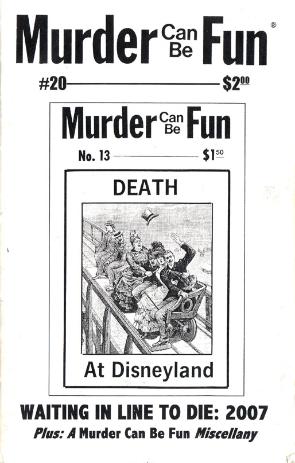 MARK: Back to the Death at Disneyland issue, I’ve always wondered if the folks at Disney ever reached out to you about it.
MARK: Back to the Death at Disneyland issue, I’ve always wondered if the folks at Disney ever reached out to you about it.
JOHN: Of course not. I did give them a call when I was doing the research. Some sweet young bubbly PR person took the call and told me, “Oh, we’ll have to get back to you on that.” It’s been 20 years and I’m still waiting.
Incidentally, the Disney piece is a perfect illustration how the world of research has changed. When I wrote the original piece in the early 90s, it took me months of digging through the newspaper files at Berkeley to pin down the details.
When I updated the piece in 2007, for my final issue, the research took me less than an hour searching through the OC Register’s on-line archive and coughing up $20 for download fees.
MARK: Just to be clear, when I said that I wondered if the folks at Disney ever reached out to you, I didn’t mean in a good way… I was wondering if perhaps they tried to get you to stop you from selling that issue.
JOHN: Nope. How could they? Why would they? Disney PR people are pros. And one of the tenets of PR is not to suppress bad stuff–when it gets out, as it almost inevitably will, you just look that much worse. You can control the narrative, but you can’t quash it. Reading the original news stories, you can see the Disney spokespersons acting completely open about the accidents, and being very forthcoming in their answers to the reporter’s questions. As for keeping me from publishing, I was very scrupulous about accuracy and avoiding reproduction of any trademarked images. I even avoided using any trademarked character names, which I felt gave the article an even more sinister atmosphere! I don’t see how they could stop me, but I do see how they could get a lot of bad publicity if they tried.
Whenever I hear someone claim such and such a big organization is suppressing something, I turn on my bullshit detector. It can happen–but it’s way harder than most people think. I’ve had people who should know better ask me about the “people who were frightened to death in the Haunted House” and “the kids who were kidnapped in the park” whose stories were suppressed because the park wanted to avoid the publicity. The answer is–nope, never happened, nothing to hide. The kidnapping one is really rich–the molesters drag their victims into the bathroom to forcibly disguise them with a quick hair dye job. As though no one will notice in a crowded bathroom in the middle of some of the most policed real estate in the world.
MARK: What are you most proud of having accomplished with Murder Can Be Fun?
JOHN: Of course, I’m proud to take a zine from 100 photocopied copies to 5,000 offset copies with a readership that still remembers. But less obviously, I’m also proud of not doing the classic zine move of just never publishing a final issue (and keeping the subscription money). When I was a kid subscribing to zines, they would always fall into limbo as soon as they got my subscription check. “Hey, that was money I earned mowing lawns and pulling weeds!” I vowed if I ever did a zine, I’d bring things to a definite close. And I did. After my final issue, I sent everyone a refund.
MARK: Oh, I almost forgot to ask you about cover art…
JOHN: The first 13 issues featured mediocre appropriated imagery assembled (like everything else) by yours truly. I didn’t even do real half tones on the photos. For #14 (Mailroom Mayhem), I hired a local artist named Maxwell Malice. For the Morman issue (#15) I just grabbed some graphics. The next four (#16, #17, #18, and #19) were done by Chuck Sperry, one of the Firehouse rock poster guys. (He also made a nice silkscreen poster of the #18 cover that still pops up from time to time on Ebay.) He was going to do #20, but there was a fire in his shop, so, to my eternal regret, I resorted to my old tricks.
MARK: So, what are you up to these days? Is life OK?
JOHN: All is well. My life has only changed in magnitude since I started MCBF. I now live in a bigger place with room for more books! But I’m still in San Francisco and even have the same job. I’m doing a lot of reading, and starting to do a little bit of writing. Due to my housing situation over the past several years I’d been unable to commit to any long-term projects, but now that I’ve resolved everything permanently in my favor, I’m looking to do something again. I just wrote a little bit for the Harry Stephen Keeler Society, and I’m looking to re-boot my blog. (So cutting edge!) And I’ve been doing a lot of zine fests, which have been cropping up like weeds all over the country!
MARK: When you say you still have the same job, do you mean that you’re still at the retirement account management company that you were working at when you were 16?
JOHN: Oh, no, thank god. I’m sure they went under many years ago. I am a humble civil servant for a local government agency. I’ve been here to help you for the last 33 years.
MARK: Well, on behalf of everyone, thank you… When you’re not helping others, though, is murder still part of your life?
JOHN: Although I’m no longer as interested in factual murders, I still avidly peruse the fictional variety. I’ve recently expanded my focus from midcentury hardboiled/noir to include some Edwardian stuff. I’m not writing right now, partially due to laziness, but primarily due to lack of outlets. However, I am looking to get back in the game. I’ve been hearing wonderful things about this newfangled thing called the Internet….
MARK: Well, given your background, I can’t help but think you might have a few good ideas when it comes to killing people off on the written page.
JOHN: I wrote a “confession” story back in the early 1990s that was published in True Confessions, although all the characters survived. I’ve always regretted not following up on that; there’s always been a soft spot in my heart for that type of hackdom. I would like to try my hand at more violent literary forms, but with the collapse of professional markets, who knows? I’m so old school I expect to get paid for writing.
MARK: And you did, if I’m not mistaken, branch out once or twice, didn’t you? At least I seem to recall a Murder Can Be Fun Presents: Anti-Sex Tips for Teens, right?
JOHN: I did two unnumbered issues, the Anti-Sex Tips (devoted to all those super-sqaure teen advice books) and Obscure Crime Books (reviews of some of the gems of my collection). The latter is probably my rarest issue; it had a relatively low press run and I never reprinted it.
MARK: Can you maybe pass along one anti-sex tip, as I’m sure some reading this would appreciate it?
JOHN: Always sleep with the windows open. And no novel reading for you ladies, lest you become “sexually infirm.”
MARK: And there was also a comic anthology, right? How’d that come about?
JOHN: An editor of Slave Labor Graphics approached me and I agreed on the condition that they do all the work–because I know nothing about comic books. And, except for a short prose piece I contributed to each issue, they kept their word! Some of the stories were adapted directly from MCBF, others were originals that shared the theme.
MARK: Are back issues of Murder Can Be Fun still available?
JOHN: I still have copies of #11, #12, #16, and #18 through #20, along with the 1994, 95, 96, and 97 Datebooks. It’s a good thing so many issues have gone out of print because I was evicted from my storage space last year!
MARK: One last question… What was your favorite murder, and why?
JOHN: That’s like asking Octomom who her favorite kid is! So many interesting cases, so little time….
[note: If you like what you’ve read and want more about the American underground press and the people behind it, be sure to check the other interviews in the History of Zines series.]

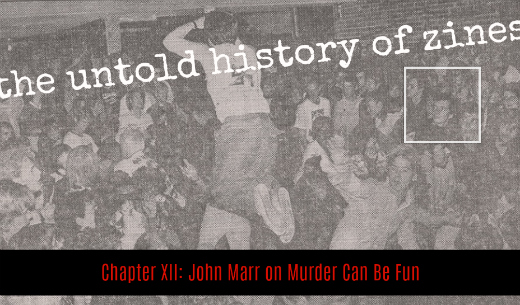
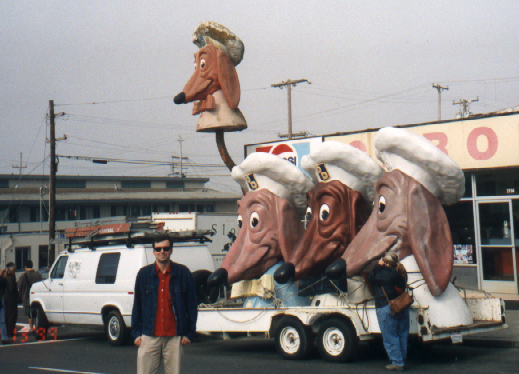

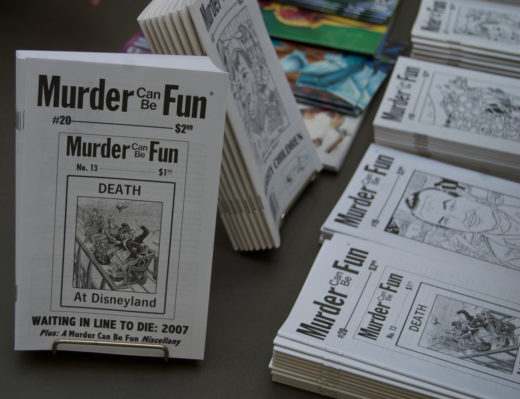
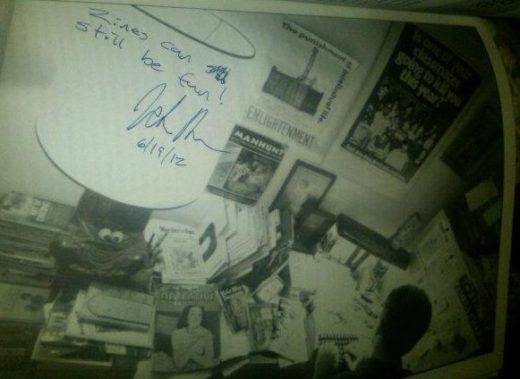
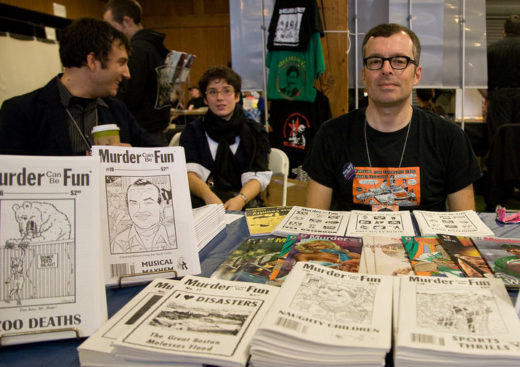
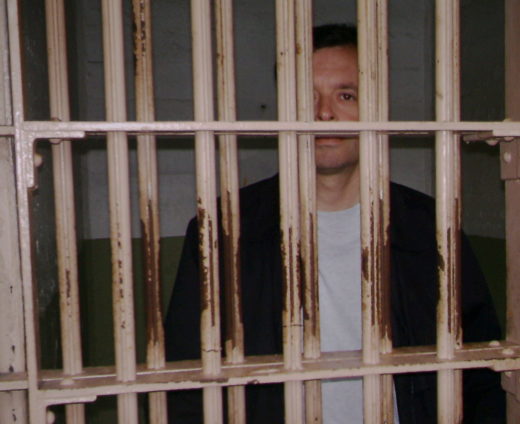







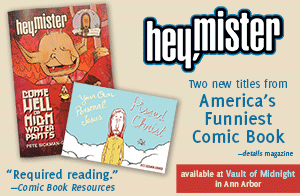



8 Comments
Johnny is the best. Great guy.
I had no idea the Hardy Boys started out cool.
I always loved Murder Can Be Fun. John could really spin a tale. The internet, as good as it is, ruined a lot of what made this world such a great, interesting place. The thrill of discovery a few decades ago was real. People would give you mixed taped. You’d find zines. Now there’s the internet. It provides everything, and does so immediately.
Is that a Cookie Monster lamp?
Speaking of Death at Disneyland, I took this photo a few weeks ago in Pittsburgh, at the Carnegie Museum.
thanks mark, that was a good read!
Where can I buy some of the available back issues?
I loved MCBF and eagerly bought issues whenever I could find them. Which wasn’t often enough even in the zine heyday of the 90s. I would love it if an anthology of the issues would get released in book form.
2 Trackbacks
[…] the spring of 1994, where we sold all kinds of zines, comics, and magazines, including Factsheet 5, Murder Can be Fun, King Cat, ReSearch books, Dirty Plotte, 8-Track Mind, etc… We were big Factsheet 5 fans. I […]
[…] As luck would have it, our mutual friend, John Marr, of Murder Can Be Fun fame, just happened to have a copy fo Pathetic Life #10 laying around, and he sent me the following scan […]